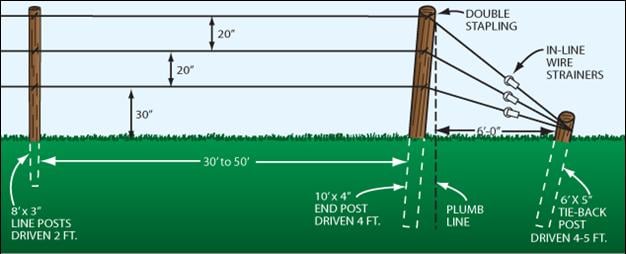Resources
Three-Wire Verticle Trellis (Fruit Trees)
 Perhaps the most versatile type of high-tensile wire trellis, the 3-wire vertical-or "leaf palmette"-is one of the most common. It is based on American and European vertical trellises which have from two to five wires to support concentrated plantings of fruit trees. Its overall design may appear to be similar to trellises built for years with low-tensile wire and untreated posts, but this superior 3-wire trellis has been engineered to make efficient use of MAX-TEN 200 High-Tensile Fence Wire.
Perhaps the most versatile type of high-tensile wire trellis, the 3-wire vertical-or "leaf palmette"-is one of the most common. It is based on American and European vertical trellises which have from two to five wires to support concentrated plantings of fruit trees. Its overall design may appear to be similar to trellises built for years with low-tensile wire and untreated posts, but this superior 3-wire trellis has been engineered to make efficient use of MAX-TEN 200 High-Tensile Fence Wire.

Three-wire vertical trellises are generally between 60 and 72 inches high and are commonly used to support many varieties of dwarf and semi-dwarf apple trees which are typically spaced 8 feet apart. This trellis can be built higher, and with up to five wires, to support other varieties of dwarf and semi- dwarf trees. Standard apple trees and other types of fruit trees may also be planted, but tree height and weight may require modifications in the support system (see description of 6-wire trellis that follows). Three-wire trellis rows are typically spaced 12 feet apart and can be virtually any length, depending on topography and access points needed. Higher trellises require wider row spacings to provide adequate exposure to sunlight. Post spacing within rows is from 30' to 50'.
Depending on topography and row length, various types of brace assemblies may be used. See Table 7 in the section on "CONSTRUCTING END POST BRACE ASSEMBLIES". For 3-wire trellises less than 800 feet long, a tie-back brace assembly can be used. Trellises between 500 and 2000 feet, and those with three or more wires, require single-span brace assemblies. Higher and longer trellises, and those with more wires, may require additional end-brace assemblies to separate independent sections of trellis. For detailed information on constructing a 3-wire Vertical Trellis, see the section on "BASIC METHODS OF CONSTRUCTION".

GENERAL SPECIFICATIONS FOR A TYPICAL 3-WIRE TRELLIS
Wire spacing from ground up: 30", 20", 20"
SINGLE-SPAN BRACE ASSEMBLIES:
- End post length and diameter (two required for each trellis row): 8' x 5", driven 4'
- Brace posts (two required for each trellis row): 10' x 4" driven 4'
- Horizontal top braces (two required for each trellis row): 8' x 4"
- Brace pins: one 3/8 x 4" and one 3/8" x 9" galvanized steel pin per end assembly
- Twitch sticks: 1 1/2" x 2" x 24" pressure-treated wood, one per end assembly
- Diagonal brace wire: 48' length of MAX-TEN 200 High-Tensile Fence Wire, two wraps
With Tie-back Brace Assemblies:
The following material are used only in a tieback brace assembly, and are use in place of the above materials
- Tie-back post (2 for each trellis): 8' x 5" top can be cut off after driving
- End post (2 for each trellis): 10' x 4"
Other materials
- Line posts: 8' x 4", driven 2'
- Post spacing: 30' to 50' on centers, depending on terrain
- Wire: MAX-TEN 200 High-Tensile Fence Wire
- Minimum wire tension: 250 lbs. per wire
- Staples: 1 3/4" galvanized, slash-cut points, double staple wires to tie-back end posts
- Tension devices; one In-Line Wire Strainer per wire (and one handle)
- Tension Indicator Spring: (optional)
- Wire splices: three Kiwi Gritted Crimp Sleeves, or one Quik-Splice, or a figure 8 knot
- End post wire fasteners: two crimped Kiwi Gritted Crimp Sleeves, or an end post knot, or one Quik-End
- Grounding (for dry soil, one ground rod per each 150', moist soil, one per each 300'). Needed for each grounding location:
- Ground rod (6' length of 1/2" or 5/8" galvanized steel rod, or 3/4" galvanized new steel pipe)
- Ground clamp - one per rod
- Grounding wires: five 8' lengths of MAX-TEN 200 High-Tensile Fence Wire
An excerpt from How To Build Orchard and Vineyard Trellises - 47 pages of detailed instructions for using Max-Ten high-tensile trellis wire for a stronger, longer-lasting support system. Free shipping on this great how to for trellis design and construction.










